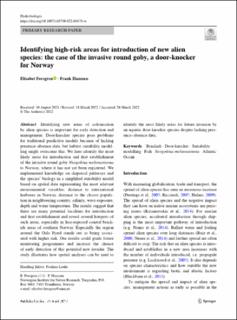| dc.contributor.author | Forsgren, Elisabet | |
| dc.contributor.author | Hanssen, Frank Ole | |
| dc.coverage.spatial | Norway, Oslo Fjord | en_US |
| dc.date.accessioned | 2022-05-10T11:03:15Z | |
| dc.date.available | 2022-05-10T11:03:15Z | |
| dc.date.created | 2022-04-26T16:10:48Z | |
| dc.date.issued | 2022 | |
| dc.identifier.issn | 0018-8158 | |
| dc.identifier.uri | https://hdl.handle.net/11250/2995020 | |
| dc.description.abstract | Identifying new areas of colonisation by alien species is important for early detection and management. Door-knocker species pose problems for traditional predictive models because of lacking presence–absence data, but habitat suitability modelling might overcome this. We here identify the most likely areas for introduction and frst establishment of the invasive round goby Neogobius melanostomus to Norway, where it has not yet been registered. We implemented knowledge on dispersal pathways and the species’ biology in a simplifed suitability model based on spatial data representing the most relevant environmental variables: distance to international harbours in Norway, distance to the closest population in neighbouring country, salinity, wave exposure, depth and water temperature. The results suggest that there are many potential localities for introduction and frst establishment and reveal several hotspots of such areas, especially in less-exposed coastal brackish areas of southern Norway. Especially the region around the Oslo Fjord stands out as being associated with higher risk. Our results could guide future monitoring programmes and increase the chance of early detection of this potential new invader. The study illustrates how spatial analyses can be used to identify the most likely areas for future invasion by an aquatic door-knocker species despite lacking presence–absence data. Brackish · Door-knocker · Suitability modelling · Fish · Neogobius melanostomus · Atlantic Ocean | en_US |
| dc.language.iso | eng | en_US |
| dc.rights | Navngivelse 4.0 Internasjonal | * |
| dc.rights.uri | http://creativecommons.org/licenses/by/4.0/deed.no | * |
| dc.title | Identifying high‑risk areas for introduction of new alien species: the case of the invasive round goby, a door‑knocker for Norway | en_US |
| dc.title.alternative | Identifying high‑risk areas for introduction of new alien species: the case of the invasive round goby, a door‑knocker for Norway | en_US |
| dc.type | Peer reviewed | en_US |
| dc.type | Journal article | en_US |
| dc.description.version | publishedVersion | en_US |
| dc.rights.holder | © 2021 The Authors | en_US |
| dc.subject.nsi | VDP::Zoologiske og botaniske fag: 480 | en_US |
| dc.subject.nsi | VDP::Zoology and botany: 480 | en_US |
| dc.source.pagenumber | 2377–2394 | en_US |
| dc.source.volume | 849 | en_US |
| dc.source.journal | Hydrobiologia | en_US |
| dc.identifier.doi | 10.1007/s10750-022-04878-w | |
| dc.identifier.cristin | 2019272 | |
| dc.relation.project | Andre: Norwegian Environment Agency | en_US |
| cristin.ispublished | true | |
| cristin.fulltext | original | |
| cristin.qualitycode | 1 | |

